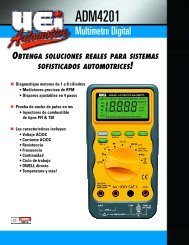Manual - UEi Automotive
Manual - UEi Automotive
Manual - UEi Automotive
Create successful ePaper yourself
Turn your PDF publications into a flip-book with our unique Google optimized e-Paper software.
28. Gnd: This annunciator indicates the Ground test function<br />
is selected.<br />
29. O2: This annunciator indicates the O2 Sensor test function<br />
is selected.<br />
30. BatDr: This annunciator indicates the Battery Drain test<br />
function is selected.<br />
31. : This symbol indicates the Diode test function is selected.<br />
32. : This symbol indicates the Continuity test function<br />
is selected.<br />
33. : Low Battery alert. Replace the battery as soon as possible<br />
to ensure accuracy.<br />
34. DATA: Secondary display for Dual Display data.<br />
35. CC... : These annunciators indicate the function being selected<br />
and/or the appropriate measurement units.<br />
36. : Analog bar-graph with scale.<br />
Operating Instructions<br />
Voltage (V)<br />
1. Set rotary selector to position. The meter defaults at DC.<br />
2. Press menu key 2 momentarily to select AC, and press<br />
twice to select Hz in the secondary display, if required.<br />
3. Insert red lead into “V” terminal and black lead into<br />
“COM” terminal.<br />
4. Touch black probe to ground or negative side of the circuit and<br />
touch red probe to positive side of the circuit coming from the<br />
power source (Fig 2).<br />
5. Set rotary selector to m position for voltage application below<br />
0.4 V with similar operation procedures.<br />
6. Refer to Dual Display RPM function.<br />
NOTE: Voltage must be measured in parellel (red probe<br />
measuring circuit from power source).<br />
The analog bar graph is easier to read when the data causes the digital<br />
display to rapidly change. It is also useful for trend setting or directional<br />
data.<br />
RPM<br />
Making Measurements and Tests<br />
All measurements and tests are made by first setting the rotary selector<br />
switch to a function setting (so that the meter is put in the default<br />
measurement function) and then selecting a measurement from the<br />
menu keys. Note that not all function knob settings have corresponding<br />
menu key settings.<br />
For example, the steps below show how to make an AC voltage<br />
measurement.<br />
1. Set the rotary selector switch to position for voltage<br />
measurements. Then, the meter is set to the default DC voltage<br />
measurement mode.<br />
2. Select the menu key 2 for AC voltage measurement (Fig 1).<br />
3. Connect the test leads to the measurement points.<br />
Parallel Connection<br />
(Fig 2)<br />
Dual Display RPM<br />
This function is available for the primary functions; DC, mV, AC mV, DC<br />
V, AC V, Dwell, ms-Pulse, and Duty Cycle. The trigger level selection is<br />
not available for this function, but available for the primary display<br />
RPM function.<br />
1. Set the meter to the corresponding primary function.<br />
(Fig 1)<br />
RPM<br />
2. Press button to toggle between RPM (for 4-stroke<br />
engine) and RPM (for 2-stroke or DIS engine).<br />
3. Insert the Dual Banana Connector into the RPM - and the RPM +<br />
input terminals as shown. Ensure the plug with the Ground Tab<br />
goes into the RPM - terminal.<br />
4. Clamp the inductive pickup to a spark plug wire with the arrow<br />
sign facing the spark plug as shown. Ensure the pickup jaws are<br />
completely closed (Fig 3).<br />
ADM5201-MAN P. 3













